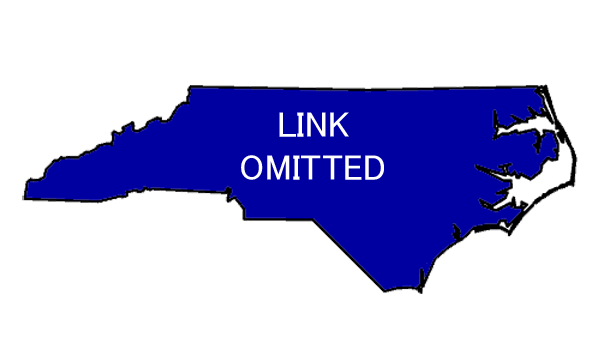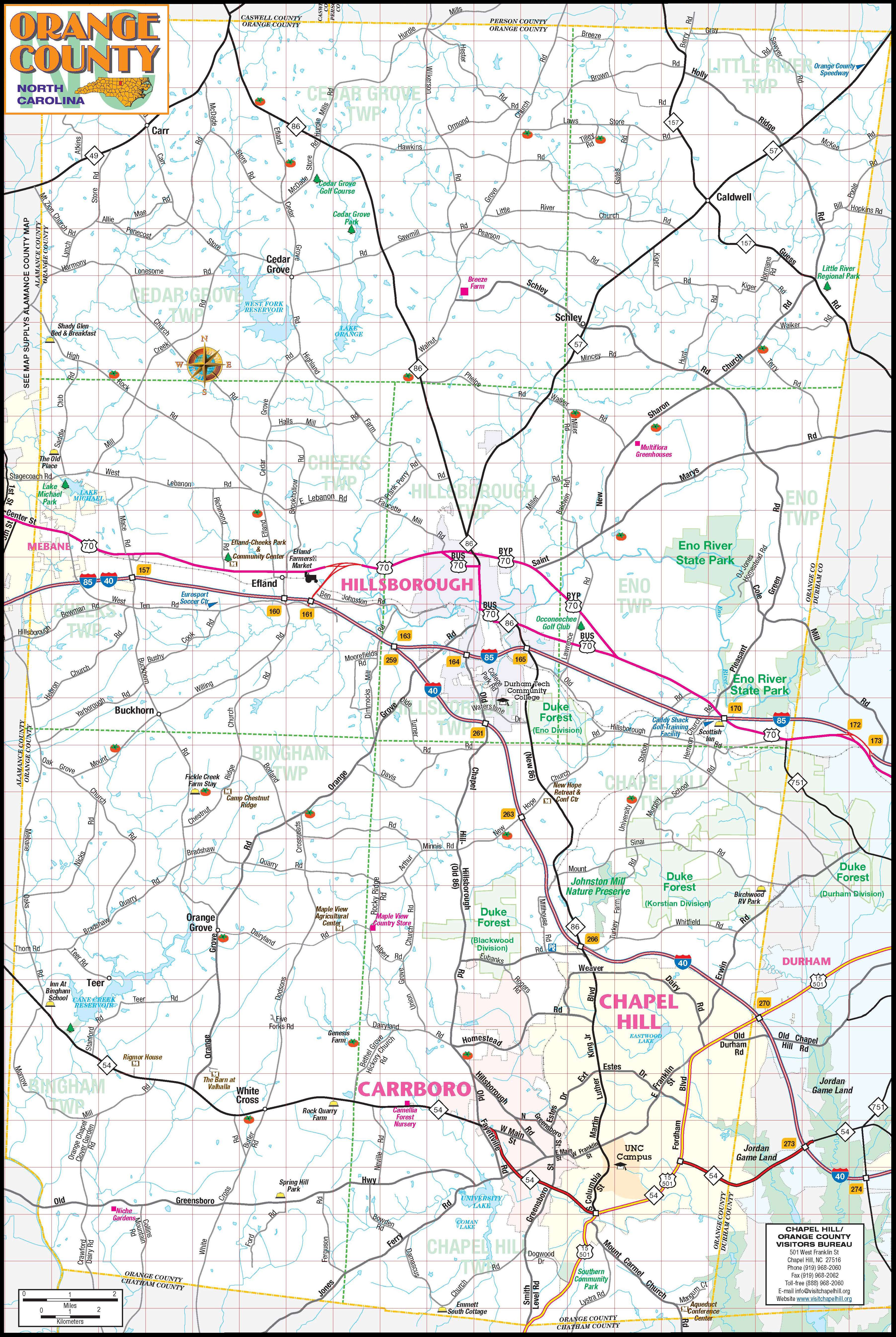
Home - North Carolina
The American Revolution in North Carolina
The Battle of Hillsborough
September 12, 1781
Killed:
Wounded:
Captured:
Original County:
15
20
200
Orange County
Killed:
Wounded:
Captured:
Present County:
0
1
0
Orange County
image adapted from image on visitchapelhill.org

In June of 1781, Thomas Burke was elected the new governor of North Carolina. He wanted to eliminate the Loyalists' stronghold between the Pee Dee River and the Cape Fear River and he had Brigadier General John Butler of the Hillsborough District Brigade of Militia to raise a large army to undertake this effort.
Militiamen from Caswell, Randolph, Chatham, Wake, and Orange counties gathered at Ramsey's Mill in the fork of the Deep River and the Haw River. Governor Burke left the relative safety of Halifax and traveled to Hillsborough to direct the upcoming campaign against the Loyalists. He and his wife arrived on September 9th - and this news was somehow provided to Loyalist Col. David Fanning.
After the battle of Little Raft Swamp, volunteers poured into Col. Fanning's camp. He now had the largest force of his career - 950 men. Unfortunately, only 435 were equipped and armed. He proposed a plan to Major James H. Craig in Wilmington - his plan to capture Governor Thomas Burke. Major Craig realized that this would be a significant coup and he approved Fanning's plan.
On September 9th, Col. Fanning was joined at Cox's Mill by Col. Hector McNeill and his 70 men, and Col. Archibald McDugald with 200 Highlanders from Cumberland County. Fanning had not worked with McDugald before, but knew of him from John Hamilton's Royal North Carolina Regiment.
On September 11th, his army of over 600 Loyalists marched towards Hillsborough. Col. Fanning was aware that Brigadier General John Butler was at Ramsey's Mill, but he left the marching column and rode to a friend's house on the way to make sure that the Patriot army had not moved. The Patriots were still to the southeast, but Col. Fanning learned that a small force of twenty-five men were camped at the New Hope River, between Col. Fanning and Brigadier General Butler.
Upon his return to his own army, Col. Fanning discovered that Col. McNeill and Col. McDugald were under the wrong impression that Brigadier General Butler's army was their target - and, they had moved the Loyalists onto the road leading to Ramsey's Mill far to the south of Hillsborough. Col. Fanning stopped the column and kindly informed the officers what their true objective was. He then sent Capt. Richard Edwards and thirty men to go after the Patriots on the New Hope River.
After marching all day and night, the large Loyalist army arrived at Hillsborough in an early morning fog. Col. Fanning divided his force into three groups and surrounded the city. At seven o'clock he attacked. The surprise was so complete that a small force of NC Continentals that just happened to be in town didn't have time to react. The only real resistance was from some snipers who fired from windows of nearby homes. These were quickly silenced.
Col. David Fanning rushed to the governor's house to find that Governor Thomas Burke and his men were willing to fight to the death. He then rode up to them and somehow convinced them that if they surrendered their lives would be spared. Governor Burke had heard that Fanning was a man of his word, so he accepted the terms and handed over his own sword.
Several Patriots in town tried to escape during the raid. One officer was wearing a military helmet as he was running to get away. Col. Fanning rode up to him and broke his sword on the officer's metal helmet. The officer was Lt. Col. Archibald Lytle of the NC Continental army, who had taken parole at the Fall of Charlestown a year before.
The final resistance was from the small contingent of North Carolina Continentals who had barricaded themselves inside a nearby church. Most were fresh, new, and untrained recruits for Major General Greene's army in South Carolina, and they soon gave themselves up.
By nine o'clock in the morning, the town was taken, including the governor, the city council, a number of Continental officers and seventy-one soldiers, mostly militiamen.
The town jail was opened and thirty Loyalist prisoners who were to be hanged that day were released. Col. Fanning's men also grabbed two swivel guns from the jail. The Loyalists should have left at that point, but discipline broke down and a number of homes were plundered. Some Loyalists found a liquor supply and proceeded to get drunk. A tee-totaler, Loyalist Capt. John McLean, was placed in charge of the prisoners. From that day on, he was known as "Sober John" McLean.
Around two o'clock in the afternoon, Col. Fanning finally left with his prisoners and marched towards his camp at Cox's Mill in Randolph County. Some of his followers were so drunk that they could not keep up, and they became prisoners themselves before the end of the day. The large force stopped after about eighteen miles and camped near Mitchell Mountain for the night.
That night, Col. Hector McNeill had a dream that he took to be a premonition of his own death. He told several officers, including Col. Archibald McDugald, about the dream. They attempted to cheer him up, but the next day he wore a hunting shirt instead of his red regimental coat just in case.
This Loyalist raid was probably the most daring of the entire war, and has since been hailed as "the most brilliant exploit of any group of Loyalists in any state throughout the Revolution."
Governor Thomas Burke and most of the prisoners were taken to Wilmington and handed over to Major James H. Craig of the British Army. Governor Burke was soon transported to Charlestown, South Carolina, where he was imprisoned at James Island.
Governor Thomas Burke - Commander
Capt. John DeCoin - Governor Burke's Life Guard (POW), from Edgecombe County Regiment
John Huske (POW) - Governor Burke's Secretary
Col. George Lytle - Hertford County Regiment (POW-paroled)
NC Continentals detachment led by Lt. Col. Archibald Lytle (POW-exhanged 2/9/1782) - 71 men
NC Light Horse Regiment detachment led by Col. James Read
(POW), with two (2) known companies, led by:
- Capt. Thomas Thompson (POW)
- Capt. James Trousdale (POW)
Orange County Regiment of Militia detachment led by Lt. Col.
Abisha Thomas (POW-paroled), Major John Estes (POW until 1/12/1782)
and Major William McCauley (POW-paroled), with four (4) known
companies, led by:
- Capt. Richard Christmas (POW-held 11 mos)
- Capt. John Clendenen (POW)
- Capt. Matthew McCauley (POW-held 6 mos)
- Capt. William Rogers
Chatham County Regiment of Militia detachment of two (2) known
companies, led by:
- Capt. John Mayben (POW-paroled)
- Capt. Matthew Ramsey (POW)
Col. David Fanning - Commanding Officer
Randolph County Regiment of Loyalist Militia led by Col. David
Fanning, with 435 men in six (6) known companies, led by:
- Capt. John Rains
- Capt. Ben Underwood
- Capt. John Elrod
- Capt. William Deaton - Chatham County Militia
- Capt. Edward Edwards - Orange County Militia
- Capt. Stephen Holloway - Orange County Militia
Royal North Carolina Militia of Bladen County, led by Col. Hector McNeill, with 70 men
Royal Militia of Cumberland County, led by Col. Archibald
McDugald, with 200 men in two (2) known companies, led by:
- Capt. "Sober John" McLean
- Capt. Archibald McKay
Gov. Martin's Corps led by Capt. Alexander McGraw
-
-
-
-
-
-

Carolina

South Carolina